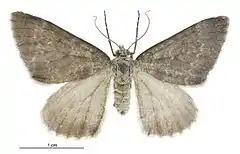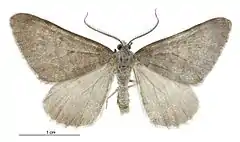Helastia clandestina
Helastia clandestina is a moth of the family Geometridae. This species is endemic to New Zealand. It is classified as "At Risk, Relict'" by the Department of Conservation.
| Helastia clandestina | |
|---|---|
 | |
| Female | |
 | |
| Male | |
| Scientific classification | |
| Kingdom: | |
| Phylum: | |
| Subphylum: | |
| Class: | |
| Order: | |
| Family: | |
| Genus: | |
| Species: | H. clandestina |
| Binomial name | |
| Helastia clandestina | |
| Synonyms[2] | |
| |
Taxonomy
This species was first described by Alfred Philpott in 1921 using a specimen collected by E.S. Gourlay at Arthur's Pass and named Xanthorhoe clandestina.[3][2] George Hudson discussed and illustrated this species in his 1928 book The Butterflies and Moths of New Zealand under the same name.[4] In 1987 Robin C. Craw placed this species within the genus Helastia.[5] The holotype specimen is held at the Canterbury Museum.[2]
Description
Philpott described the species as follows:
♂︎. 35 mm. Head and palpi grey-whitish. Eyes olive-brown. Antennae dark grey, pectinations 5 but appearing shorter owing to being basally appressed to the shaft. Thorax grey. Abdomen whitish-grey. Fore-wings elongate-triangular, costa sinuate, apex bluntly pointed, termen straight, oblique ; bluish-grey ; lines faintly indicated in darker ; an irregular basal line at 1⁄6 ; first line at 1⁄3, double, slightly waved ; discal spot rather elongate, transverse, dark ; a fairly straight, slightly waved, median line ; second line from 2⁄3 costa to 3⁄4 dorsum, excurved on upper half, faintly margined with white on veins : cilia white, basally mixed with grey. Hindwings grey, slightly darker round termen : cilia white.[3]
Distribution
This species is endemic to New Zealand.[6][1] It occurs in Westland, North Canterbury and Mid Canterbury.[7]
Biology and lifecycle
Very little is known about the biology of H. clandestina.[8] Hudson records it being on the wing in February.[4]
Host species and habitat
The host species for the larvae of H. clandestina is unknown.[7] H. clandestina prefers stony riverbed habitat such as at the Waimakariri River flood plain.[7][8]
Conservation status
This moth is classified under the New Zealand Threat Classification system as being "At Risk, Relict".[9]
References
| Wikimedia Commons has media related to Helastia clandestina. |
| Wikispecies has information related to Helastia clandestina. |
- "Helastia clandestina (Philpott, 1921)". www.nzor.org.nz. Landcare Research New Zealand Ltd. Retrieved 2018-05-16.
- Dugdale, J. S. (1988). "Lepidoptera - annotated catalogue, and keys to family-group taxa" (PDF). Fauna of New Zealand. 14: 181. Retrieved 15 May 2018.
- Philpott, Alfred (1921). "Notes and descriptions of New Zealand Lepidoptera". Transactions and Proceedings of the New Zealand Institute. 53: 337–342. Retrieved 16 May 2018.
- Hudson, G. V. (1928). The Butterflies and Moths of New Zealand. Wellington: Ferguson & Osborn Ltd. p. 113.
- Craw, R. C. (1987). "Revision of the genus Helastia sensu stricto with description of a new genus (Lepidoptera: Geometridae: Larentiinae)". New Zealand Journal of Zoology. 14 (2): 269–293. doi:10.1080/03014223.1987.10422997.
- Gordon, Dennis P., ed. (2010). New Zealand inventory of biodiversity. Volume two. Kingdom animalia : chaetognatha, ecdysozoa, ichnofossils. Vol. 2. Christchurch, N.Z.: Canterbury University Press. p. 459. ISBN 9781877257933. OCLC 973607714.
- Patrick, Brian; Dugdale, John S. (2000). Conservation status of the New Zealand lepidoptera (PDF). Wellington, N.Z.: Department of Conservation, New Zealand. p. 24. ISBN 978-0478218671. OCLC 154670803.
- Pawson, S.M.; Emberson, R.M. (2000). "The conservation status of invertebrates in Canterbury" (PDF). Conservation Advisory Science Notes. 320: 1–64.
- Hoare, R.J.B.; Dugdale, J.S.; Edwards, E.D.; Gibbs, G.W.; Patrick, B.H.; Hitchmough, R.A.; Rolfe, J.R. (2017). Conservation status of New Zealand butterflies and moths (Lepidoptera), 2015 (PDF). Wellington, New Zealand: New Zealand Department of Conservation. p. 7. ISBN 9781988514383.